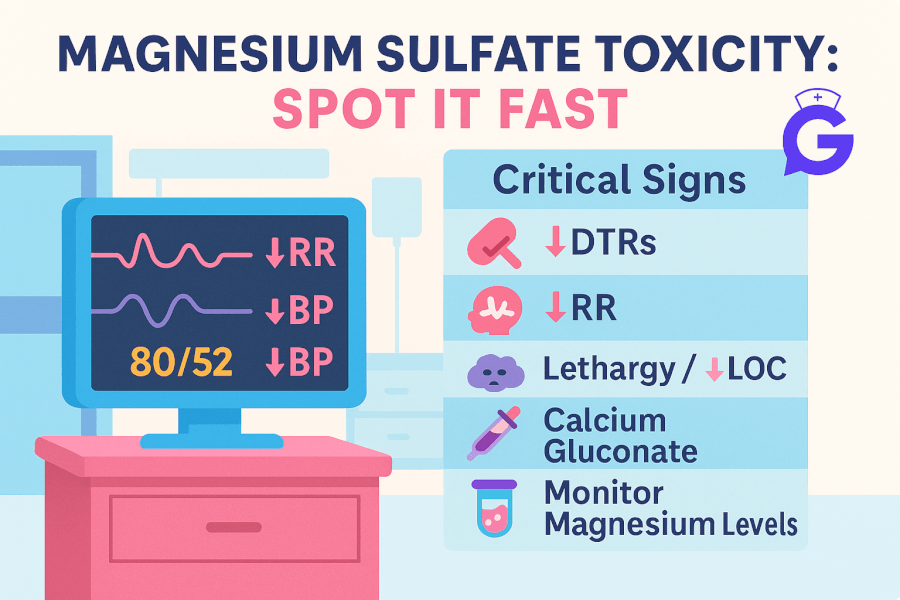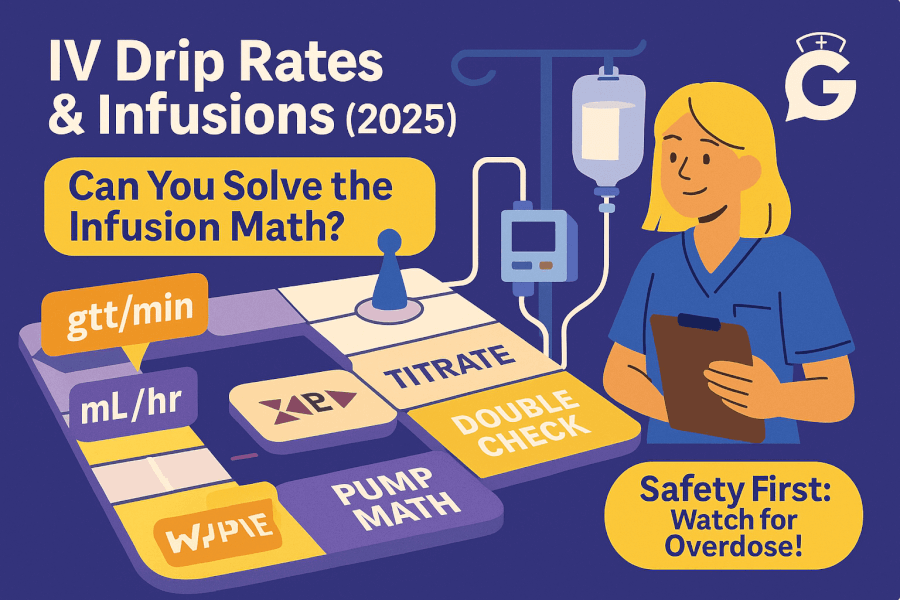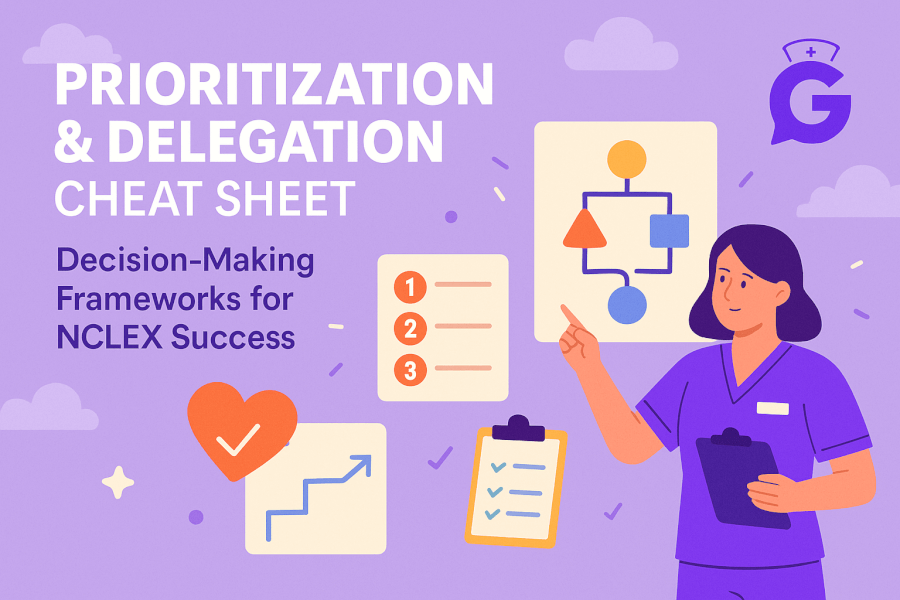If you’re deciding which AI app to use for nursing school, you probably want one thing: less time formatting and more time thinking like a nurse. This honest, student-first comparison shows where AI truly helps—care plans, pharmacology sheets, NGN practice—and where it doesn’t. You’ll also see privacy notes (HIPAA/FERPA), a quick decision tree, and prompt examples you can use tonight.
Bottom line: the “best AI” depends on your job-to-be-done—care plans, pharm, or NGN reasoning. The picks below make that choice fast.
Table of Contents
- Quick Picks (who should choose what)
- Feature Comparison Matrix
- Use Cases with Prompt Examples
- Privacy & Academic Integrity (HIPAA/FERPA)
- Decision Tree: 3 Questions to Pick Your Tool
- FAQs
- Further Reading
🎯 Free NCLEX quiz!
Test your knowledge - new quizzes added weekly!
Quick Picks (who should choose what)
- Care-plan heavy term? Choose a tool that reliably outputs tables/checklists and lets you export cleanly.
- Pharmacology focus? Use an app that summarizes mechanisms/adverse effects into studyable bullets and supports citations you can verify.
- NGN prep? Use a tool that supports prompt templates, history, and low “reasoning drift,” then drill with realistic cases: see NGN Case Studies (2025): 25 Free Examples.
- Need ready-made prompts? Start with the AI Prompt Library for Nursing Students (2025).
- New to AI in school? Read the orientation guide first: AI in Nursing Education (2025): Complete Guide.
Feature Comparison Matrix
The table below is use-case first. It groups common options you’ll see on campus or online. Exact pricing/features can change—use this as a fit check and verify details on the vendor page.
| Option (Type) | Best For | Strengths for Nursing | Limitations | Export / Workflow | Privacy / Notes |
|---|---|---|---|---|---|
| GoodNurse (AI nursing tutor) | Care plans, pharm sheets, NGN-style reasoning practice | Structured outputs (tables/checklists), nursing-specific prompts, links to NGN cases & free quizzes | Still verify against your text and facility policy | Copy/paste to docs; interlinks to NGN hub and quizzes | Built for nursing use; de-identify scenarios; follow syllabus |
| General-purpose AI chatbots (e.g., widely used LLMs) | Fast brainstorming; basic care-plan or pharm drafts | Flexible; good at reformatting into tables and bullets | Can drift or “sound right” but be wrong; needs strong prompts | Easy copy/export; good for quick iterations | Never paste PHI; confirm facts with textbook/drug guide |
| Study workspace AI (e.g., notes/doc tools with AI) | Turning lecture notes into study guides; team study | Organizes long notes; can summarize and outline | May be generic for nursing specifics; watch hallucinations | Strong doc export; good for checklists | Respect institutional policies; avoid uploading PHI |
| Flashcard/quiz tools with AI helpers | Active recall & spaced repetition | Great for lab values, pharm, definitions | Reasoning depth (NGN) often limited without custom prompts | Deck export/import; mobile friendly | Cite sources; verify accuracy of auto-generated cards |
| Search + AI (answer engines) | Quick overviews, guideline awareness | Fast orientation to unfamiliar topics | Not a replacement for primary sources; watch date context | Copy links; create reading lists | Fact-check; do not use for patient-specific instructions |
Tip: whichever tool you choose, pair actions with parameters you’ll recheck soon (10–30 minutes when appropriate). That habit raises NGN scores. If stem reading is new, start with How to Read NGN Case Stems (2025).
Use Cases with Prompt Examples
Care plans (NANDA, SMART goals, rationales)
Use AI to format, not to think for you. Start with your priority sentence, then paste a rubric-aware prompt.
- Starter prompt: “Draft an RN-level NANDA care plan for [problem] related to [etiology] as evidenced by [cues]. Include two SMART goals, four nursing interventions with evidence-based rationales, and evaluation criteria for 24–48h. Output as a two-column table (Plan / Notes for Charting). Level: [ADN/BSN term].”
- Follow-up: “From this plan, list the two highest-priority actions that change physiology first and the two parameters that will improve in 10–30 minutes. One-line rationale per pair.”
For more, open the AI Prompt Library (2025).
Pharmacology (mechanism → adverse effects → teaching)
Turn long readings into clean reference sheets and mini-quizzes.
- Drug sheet prompt: “Create a concise pharmacology sheet for [drug/class]: mechanism, indications, high-yield adverse effects, contraindications, interactions, nursing considerations, patient teaching. Add two NCLEX-style questions with rationales. Headings + bullets.”
- Compare/contrast prompt: “Make a 4-column table comparing [class A] vs [class B]: mechanism, adverse effects, nursing considerations, teaching points.”
Tie back to NGN patterns with NGN Case Studies (2025).
NGN practice (bow-tie, matrix/grid, rationales)
Use AI to generate realistic item formats, then evaluate your reasoning against reliable patterns.
- Bow-tie prompt: “Create a bow-tie item on [clinical problem] with trend data (vitals, labs, meds). Provide one correct problem, four actions (label the two best), and four parameters (label the two best). Add a key and a short rationale.”
- Matrix/grid prompt: “Create a matrix/grid on [topic] with rows for cues, actions, rationales and columns for select relevant. Limit choices to 3–5 per row. Include partial-credit scoring notes.”
Format guidance: NGN Bow-Tie Items (2025) and NGN Matrix/Grid Items (2025).
Privacy & Academic Integrity (HIPAA/FERPA)
- No PHI in prompts. De-identify thoroughly—no names, dates, room numbers, or unique identifiers.
- Cite and verify against your textbook, drug reference, and syllabus.
- Match level: declare “ADN/BSN [term]” and paste rubric bullets so the output fits what’s graded.
- Keep drafts you can defend. If you can’t explain a line, don’t submit it.
Decision Tree: 3 Questions to Pick Your Tool
-
What’s your biggest job-to-be-done this term?
Care plans → choose strong table/checklist output.
Pharmacology → choose clean summaries with citations.
NGN practice → choose template/history support and pair with real cases. -
How will you export and study?
If you print or submit, you need clean copy/paste or doc/PDF export. If you study mobile, check app support. -
What are your privacy and budget constraints?
Use tools with clear privacy docs; never upload PHI. Start with a plan that fits your actual usage (weekly hours).
Keep it simple: pick one main tool, plus one backup for notes or flashcards. Consistency beats chasing features.
FAQs
Which AI is best for nursing care plans?
Choose a tool that reliably produces structured tables/checklists and lets you export cleanly. Always verify content against your rubric and text.
Can I use AI for NGN practice?
Yes—generate bow-tie and matrix items and then check your reasoning against realistic patterns in the NGN hub. Partial credit rewards focused selections.
How do I avoid hallucinations?
Constrain outputs (“two tables + bullets”), ask for citations, and verify facts. If something seems off, prompt for the why and cross-check with your reference.
Is it okay to paste patient details?
No—avoid PHI entirely. Use generic, de-identified descriptions and never include names, dates, or identifiers.
How do I study efficiently with AI?
Use a daily micro-loop (10–20 minutes) and one weekly long block. Convert notes into questions and pair actions with parameters you can re-check soon.







